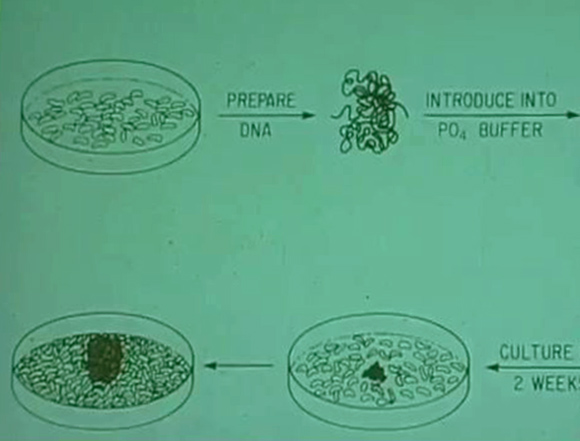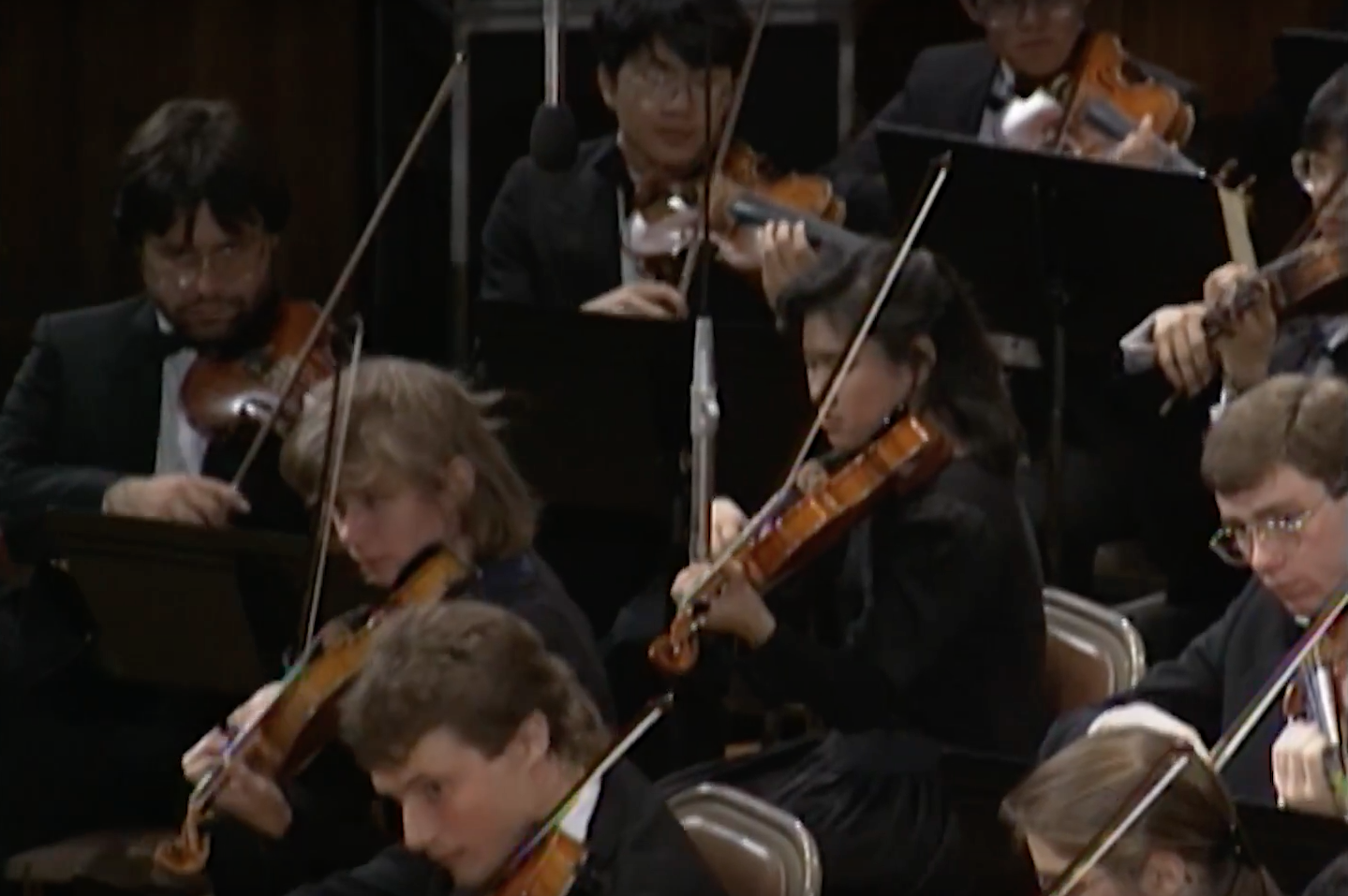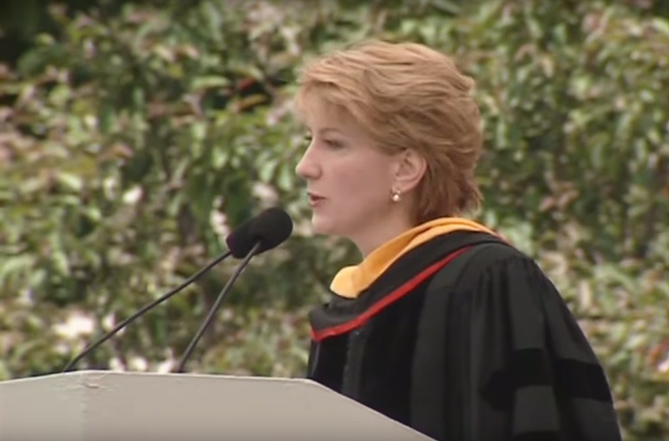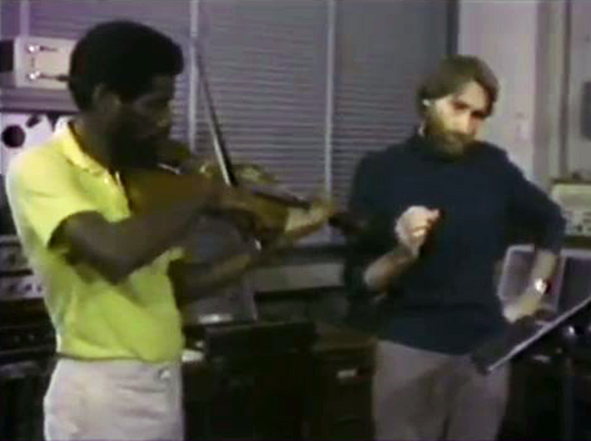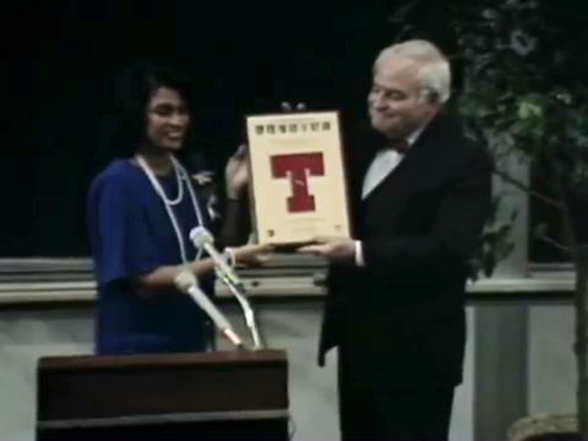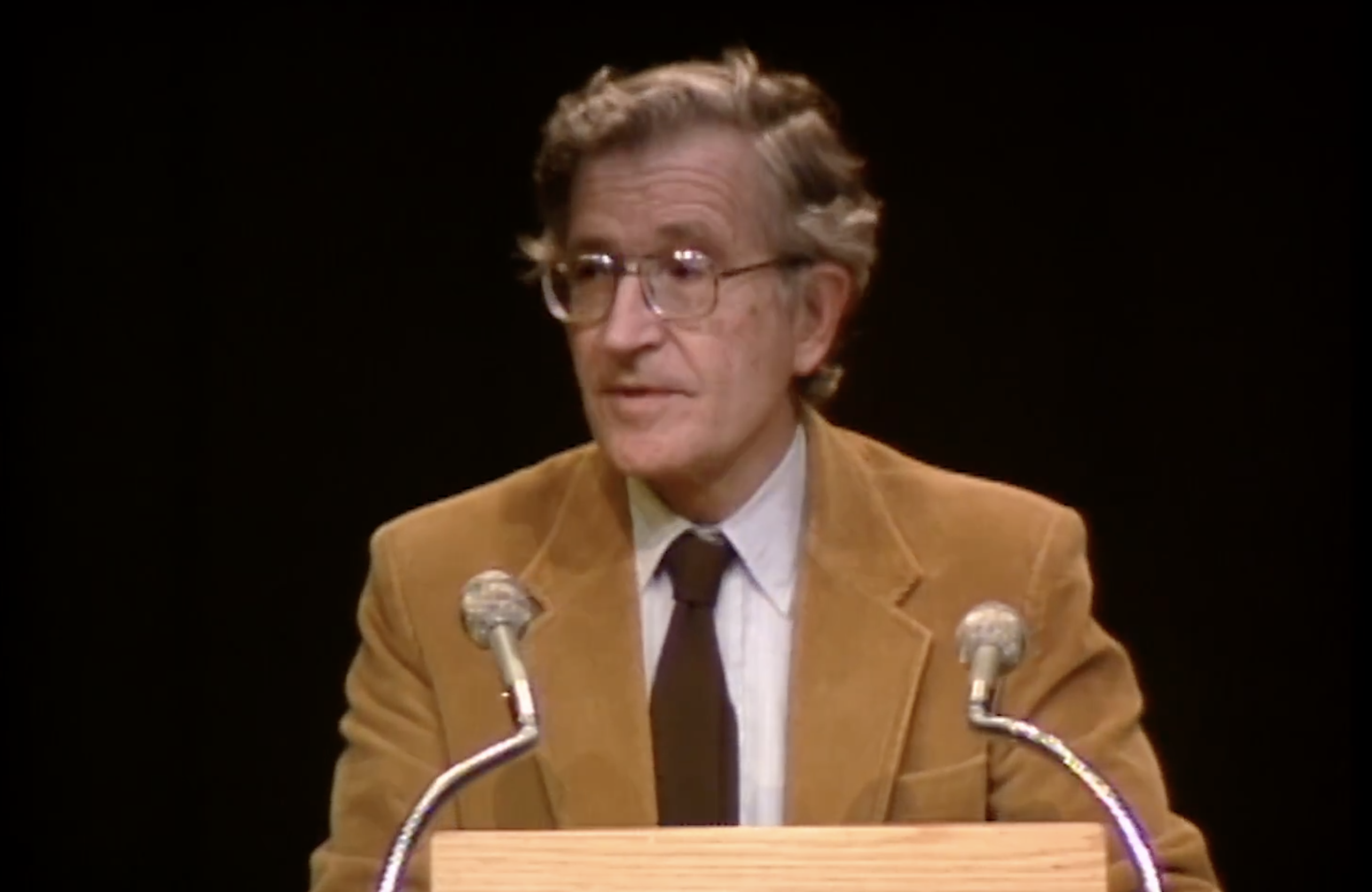Inauguration of MIT's 16th President, Dr. Susan Hockfield
DR. MEAD: And now, as chairman of the corporation of the Massachusetts Institute of Technology and on behalf of that body, it is my responsibility and my privilege to induct into office our 16th president. Well, our president's emeriti, Mr. Howard W Johnson, Dr. Paul E Gray, and Dr. Charles M Vest, please escort Dr. Hockfield to center stage for the investiture. You are well escorted.
Susan Hockfield, by the authority of the corporation and with the enthusiastic approval of the faculty, the alumni, students, staff, and this distinguished assembly, I present into your keeping the charter of the Massachusetts Institute of Technology and invest you with all the authority, privileges, and responsibility of the office of the president. May you serve the Institute with all the skill, wisdom, and dedication which our confidence accords to you and may your leadership carry MIT to even greater accomplishment.
DR. SUSAN HOCKFIELD: Dr. Mead, I accept this charter as the symbol of the presidency of the Massachusetts Institute of Technology and I do so with a full sense of the magnitude of my responsibility to this great university. I am deeply grateful for your trust and I pledge to work wholeheartedly with the corporation, faculty, staff, alumni, and students for the greatest good of this institution.
DR. MEAD: Ladies and gentleman it is now official. May I present to you the 16th president of the Massachusetts Institute of Technology, Susan Hockfield. Thank you. Thank you. Thank you. Thank you. Thank you.
To all of you gathered here in the great embrace of Killian Court, to all the students, faculty, alumni, staff, members of the corporation, and friends, thank you for your welcome to the great global family of MIT. The MIT family is in large today and honored by the presence of delegates from many of the world's leading colleges and universities. We are proud to count you as colleagues and delighted to count you as friends. The institutions you represent have been powerful drivers to democratize education, helping to liberate the mind and lives of people around the world. Together we share a duty to guide and guard this legacy of freedom.
Let me begin by offering four special thank yous. First, to the members of the search committees who first inspired me with the intelligence, enthusiasm, and values that sit at the very center of MIT. They calculated the forces holding me to another of the world's great universities and exerted just the right countervailing force to propel me here.
I owe a second and most profound thanks to all the MIT presidents who have come before, especially those who are here with us today, Howard Johnson, Paul Gray, and Chuck Vest. Together, they represent the extraordinary succession of leaders who have helped shape the world-changing institution we celebrate today.
MIT has a habit of holding onto its presidents after they leave office. People ask me, how does that work, like a car with four steering wheels? Actually, I can't explain exactly how it works, but it does work and I am immensely grateful to these three great leaders for sharing with me their institutional insight, their personal wisdom, and they're abiding love for MIT.
My third thank you goes to my closest collaborators, my family. To my devoted husband, Tom, and our wonderful daughter, Elizabeth, and her trusty golden retriever, Casey. They did not ask for this adventure, but they have been the most cheerful, intrepid, and inspiring companions I could ever hope for.
And finally, I want to thank the entire MIT community. Over the last several months, many of you have brought me, like so many beautiful gifts, your own reasons for loving MIT. You have told me your stories, shared your passions, and revealed your hopes for the institute's future. Through these gifts, you have taught me about the essence of this truly extraordinary institution.
The world knows a lot about MIT, but some of the most remarkable things you just can't know until you get here. For example, the incredible energy of the place. There's a kind of crackling drive and curiosity that fills the air. MIT feels like a stadium with no seats. Everyone is in the game, sometimes 24 hours a day.
In our celebrations this week, I've been delighted by the cascade of art and music revealing MIT's intense creativity and the fact is, that same creativity, passion and intensity, and intellectual playfulness drive everything here-- the entrepreneurial ideas, the innovations, the discoveries. The MIT you've shared with me is also a place of deep, personal integrity and a place of striking practicality.
The essential practicality that we experience here points to one more crucial factor that can't be seen from the outside. It's the wonderful way that engineering, not just as a discipline, but as a worldview, infuses every aspect of life and thinking here. The values of engineering, the rigor, the implacable curiosity, the disciplined creativity, the appetite for good, old-fashioned hard work, the passionate, enthusiastic, can-do, hands-on, fix-it-now attitude, those values are and always will be the values of MIT.
It's through the bond of these shared values that MIT succeeds in serving the nation and the world. This university is spectacularly international and at the same time, quintessentially American. Here, it doesn't matter where you come from, what you look like, who your parents are, or how much money you have. What matters is only whether you can do the work. And because our roots go deep into the soil of engineering, our branches are always reaching up toward the light of real-world applications and answers.
And while we reach toward answers to the practical challenges of our times, we also explore the great mysteries of all time. MIT scientists and scholars define the important questions at the furthest reaches of the universe, because we know that the answers to those questions will provide insight to the world's greatest puzzles in ways we cannot yet predict.
In all these ways, the MIT you've helped me see is absolutely true to its founding mission. In 1861, William Barton Rogers launched MIT to expand what he called the happy influence of scientific culture on the industry and the civilization of nations. If MIT were merely the sum of its astonishing parts, that would be enough, truly enough, but it is much more because of its exceptional unity of purpose.
It is a complex institution, but with a single mission and with a single unwavering standard of excellence in all of our departments and across the spectrum, from the most basic curiosity-driven research to the most intensely practical applications. That uniform excellence makes possible uncommon collaborations, the kind that push boundaries and that common purpose is our greatest strength because all of us, together, are engaged in service to the great human family.
We continue a tradition that has illuminated the world for centuries. Think of the names that ring this magnificent courtyard-- Aristotle, da Vinci, Newton, Darwin, Pasteur. Separated by centuries and by nations and working with different tools, they are yet united by a passionate curiosity to understand the world. These remarkable explorers all shared an ardent desire for the truth and through that same thirst, today's students and scholars are united with them.
We call these buildings surrounding us the main group and they actually tell an important story about MIT's past and also about its future. In 1916, these mighty limestone walls rose to begin the great MIT experiment on the Cambridge side of the Charles River. The new MIT displayed a kind of open architecture, literally and metaphorically too. This huge, single, interconnected building embodied the vision of an open, unified institution without internal boundaries, a place where people interested in similar problems could work together freely across what might otherwise be disciplinary divides. In their design, these buildings actually helped invent MIT and they have helped MIT invent the future.
The main group also symbolizes a century of technological triumphs. These majestic structures evoke a faith in progress that should still inspire us and they set a standard of unrelenting excellence and innovation that is still the standard we've lived by at MIT today. At the threshold of the last century, the engineers, scientists, and scholars at MIT built an institution that unleashed the potential of new insights and new technologies. Now, at the threshold of our own century, it is up to us to do the same and I believe we will do it by relying on the same openness, excellence, and invention that have brought us so far.
And what will we do? We will capitalize on our spirit of openness to create productive collaborations across our own schools and departments and with other institutions and in the public and private sectors. We will work toward intellectual openness around the world and to preserve the vital flow of international students and scholars who contribute so much to our universities and to our society as a whole. Building on our tradition of excellence and invention and working closely with our colleagues in industry and government, we will continue to serve as a preeminent engine of economic growth, a powerhouse of the innovation economy for the region, for the nation, and for the world. And we will bring all these strengths to bear as we tackle humanity's most urgent problems.
Indeed, the world has never needed MIT as much as it does now. Think how many of the major challenges of this uncertain, unsettled age are shaped by science or technology or daunting problems of quantitative analysis and complex synthesis-- energy, climate change, AIDS, stem cells, urban sprawl, global poverty, access to health care, and even the future of social security. With our expertise in interdisciplinary problem solving, MIT is uniquely equipped and obliged to make a critical difference to do the analysis, to create the innovations, to fuel the economy, and to educate the leaders the world needs now.
In that context and understanding that profound responsibility, I believe MIT must step up to the great global challenges of our day. There are many I could cite, but let me highlight just two. First, this generation is bearing witness to a fascinating convergence of engineering and the life sciences. This convergence holds the promise of transforming our lives, but it's not unprecedented. In fact, at MIT, we know the precedent very well.
70 years ago president Karl Compton insisted that the physical sciences must play a critical role in education and research at MIT. The result was nothing less than a new era in engineering. To appreciate the power of the collaborations that Compton helped spawn, you only have to think of MIT's radiation laboratory. The Rad Lab helped develop radar and radar helped win World War II.
Today engineering is making the same kind of fertile connections with the life sciences and I believe we can expect equally revolutionary results. At MIT, we have a gift for learning from one another, combining our historic strength in engineering and our newer strengths in biology and the brain and cognitive sciences, we are already opening unprecedented opportunities for educational innovation, invention, and discovery.
Geographically and intellectually, we're bringing together our computer scientists and life scientists, our linguists, philosophers, and engineers and we are already seeing a torrent of new collaborations, new insights, and new results. Just as MIT has led in those disciplines that define the information age, MIT can and must lead in this essential new field of all fields.
A second great opportunity and a great obligation is our institutional responsibility to address the challenges of energy and the environment. Over the last 30 years, these two words, energy and the environment, have gotten a little tired, tired not from overuse, but from lack of progress. I believe that the time for that progress is now. I believe that the country and the world may finally be ready to focus on these matters seriously, and again, it is our responsibility to lead in this mission.
Tackling the problems that energy in the environment present will require contributions from all of our departments and schools. Many MIT faculty are working already on new routes to renewable and sustainable energy. We need to advance the scientific and engineering work while focusing our efforts and magnifying their impact through our world-class expertise in economics, architecture and urban planning, political science, and management.
To this end, we have begun working with the faculty to develop major new institute-wide initiative on energy. This initiative will foster new research and science and technology aimed at increasing energy supply and bringing scientists, engineers, and social scientists together to envision the best energy policies for the future. We will see this initiative with resources for new interdisciplinary faculty positions and I believe that working together, we will make an enormous difference.
Of course, even these two tremendous challenges don't begin to describe all of the things we need to accomplish in the years ahead, from revising the undergraduate curriculum to setting a new standard in management education, to serving as champions for higher education and research, and informing public policy and opinion on the critical issues of our time. As MIT has always done, we must grasp the world's great challenges, we must seize the day.
The world offers us limitless opportunities for important work, but for MIT to help build a better world, we must be able to build on the strength of our own community right here. We need to do everything we can to make sure that MIT becomes an even more inspiring, more welcoming, and more enriching place to work and to live. Community springs from shared experience. It grows out of values held deeply and in common. It cannot be manufactured on demand, but it can be fostered and that is our challenge now.
Some steps are simple. MIT has always welcomed remarkable numbers of first-generation college students. To maintain that commitment, we need to amplify our ability to offer financial aid. We also need to sustain our rich diversity of ideas and cultures by building a powerful pipeline of young women and underrepresented minority students eager to pursue advanced degrees and academic careers.
But beyond these practical challenges, we need to do something less tangible but just as important. We need to recognize in ourselves a serious hunger for a richer sense of connection and community and joyfulness. I've seen this desire all over campus. I've heard it from undergraduates, from graduate students, faculty, staff, and alumni. What makes me optimistic is that I've also found an eagerness to explore new ways to enrich our campus community.
In a place like this, the rip tide of sheer busyness can overwhelm human connections. But even with the astonishing pace and pressure, this campus is dotted with the bright sales of wonderfully vibrant, small communities-- the fraternities, sororities, independent living groups in residence halls, the staggering array of co-curricular activities, and the enormous number of athletic teams and clubs. Our challenge now is to create a broad, welcoming harbor that has room for every boat.
M-I-T, three letters that summon up the image of excellence in languages across the globe, yet-- and it's a real puzzle-- MIT's light is still somewhat under a bushel especially here in the United States. There's too little understanding of what we do at MIT, much less of how well we do it. So here is our task together, to make our light shine out brightly enough to inspire in the next generation the same love and passion for truth and discovery, for creativity and problem solving that brought us all here. We need to help America fall in love all over again with the marvelous possibilities and promise of engineering and science and technology.
It's impossible to stand at the podium in a place like this on an occasion like today's and not wonder how exactly did I come to be here. My own answer is that I came by Sputnik. When that first space flight happened, I was six years old. You can do the math. I vividly remember the thrill of it, not the threat of Soviet supremacy, but the amazing excitement of knowing that through shear hard work and ingenuity, one day human beings would get to the moon.
Like so many of you, I also came to this place hand in hand with my many inspiring teachers. I once asked my thesis adviser at the NIH why he studied the architecture of the brain and I'll never forget his answer. He said, because it is beautiful. Engaging in advanced research is a special privilege. It was a tremendous joy to find work that pleased me so much and that had the potential to make such a difference in people's lives. That's how I came to be here.
Now, here we all are in the serene majesty of Killian Court, the fortunate members of an amazing community, and the heirs to an incredible intellectual inheritance, here with our friends, embraced by the eternally inspiring names inscribed in the frieze above. Each of you has your own story, your own inspirations, the people and ideas and challenges that inspired you and carried you here too. Together, we need to be that inspiration, to reveal those truths and those pathways to the next generation. We need to be the spark that ignites the passion of every child who wants to make the world a better place. We need to reach out to those young explorers and bring them with us on the great adventure of discovery and innovation that is the soul of MIT.
The presidency of this unique institution is a tremendous responsibility. Fortunately, I know that all of you will be my partners in the years to come, not individually, but together we stored this great institute, building on its magnificent past to grasp the challenge of the future. I am deeply honored that you have asked me to share the journey with you. And I thank you very much.

















